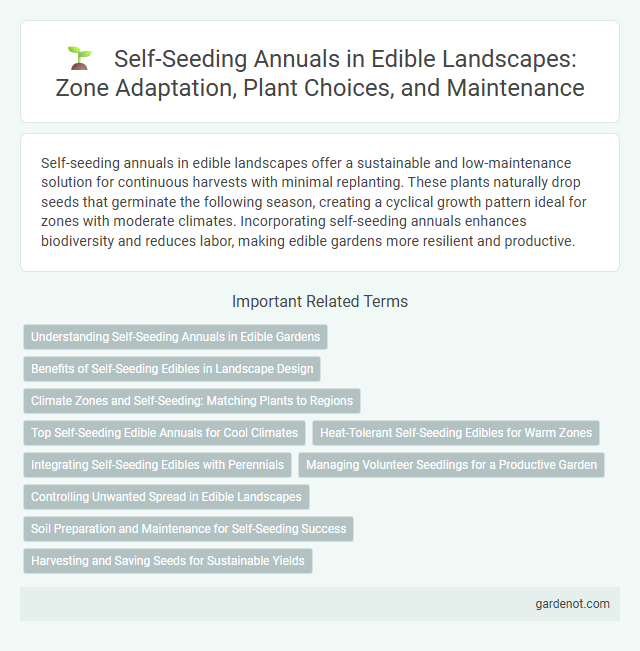Self-seeding annuals in edible landscapes offer a sustainable and low-maintenance solution for continuous harvests with minimal replanting. These plants naturally drop seeds that germinate the following season, creating a cyclical growth pattern ideal for zones with moderate climates. Incorporating self-seeding annuals enhances biodiversity and reduces labor, making edible gardens more resilient and productive.
Understanding Self-Seeding Annuals in Edible Gardens
Self-seeding annuals in edible landscapes naturally disperse seeds, ensuring continuous plant growth without replanting each season. These plants thrive in USDA Hardiness Zones 4 to 9, adapting well to diverse climates while providing sustainable harvests. Key species like lettuce, cilantro, and arugula enhance soil health and biodiversity, making them ideal for eco-friendly garden designs.
Benefits of Self-Seeding Edibles in Landscape Design
Self-seeding annuals in edible landscapes enhance biodiversity by naturally replenishing plants each growing season without replanting. These plants reduce maintenance efforts and costs while promoting soil health through continuous ground cover. Incorporating self-seeding edibles like arugula, nasturtiums, or chives supports sustainable food production and enriches garden aesthetics year after year.
Climate Zones and Self-Seeding: Matching Plants to Regions
Self-seeding annuals thrive in specific climate zones by naturally dispersing seeds to regenerate each growing season with minimal intervention. Regions with mild winters and moderate rainfall, such as USDA zones 7-10, support self-seeding varieties like Calendula, Nasturtium, and Nigella, ensuring continuous edible harvests. Selecting plants adapted to local temperature ranges and precipitation patterns enhances landscape sustainability and reduces maintenance needs.
Top Self-Seeding Edible Annuals for Cool Climates
Top self-seeding edible annuals for cool climates include kale, arugula, and nasturtiums, which thrive in zones 3-7 with cooler temperatures and shorter growing seasons. These plants naturally drop seeds at the end of their life cycle, ensuring effortless regeneration and continuous harvests year after year. Incorporating these annuals into an edible landscape promotes sustainable gardening by reducing replanting efforts and enhancing biodiversity in garden ecosystems.
Heat-Tolerant Self-Seeding Edibles for Warm Zones
Heat-tolerant self-seeding annuals such as amaranth, malabar spinach, and roselle thrive in warm zones, providing sustainable edible landscapes with minimal maintenance. These plants naturally reseed each season, ensuring continuous harvests and reducing the need for replanting. Their resilience to high temperatures and drought conditions makes them ideal for heat-prone environments while contributing nutritious greens and colorful fruits to home gardens.
Integrating Self-Seeding Edibles with Perennials
Self-seeding annuals thrive in USDA hardiness zones 4-9, offering a sustainable source of edible plants that naturally propagate each year. Integrating these self-seeding edibles with perennials enhances garden resilience, reduces maintenance, and creates a dynamic edible landscape by combining seasonal yields with long-term harvests. Popular self-seeding annuals like nasturtiums, amaranth, and chervil complement perennial herbs and vegetables, contributing to soil health and biodiversity.
Managing Volunteer Seedlings for a Productive Garden
Self-seeding annuals in edible landscapes thrive by naturally dispersing seeds, reducing the need for replanting and supporting biodiversity in USDA hardiness zones 3-9. Managing volunteer seedlings involves timely thinning and strategic transplanting to optimize spacing, improve airflow, and prevent nutrient competition, enhancing overall garden productivity. Regular monitoring ensures that only the healthiest volunteers mature, promoting a robust and sustainable yield throughout the growing season.
Controlling Unwanted Spread in Edible Landscapes
Self-seeding annuals in edible landscapes require strategic control to prevent unwanted spread, ensuring garden balance and crop productivity. Techniques such as timely deadheading, physical barriers, and regular monitoring can effectively limit seed dispersal and invasive growth. Maintaining proper zoning according to USDA Hardiness Zones helps tailor planting strategies for optimal self-seeding management.
Soil Preparation and Maintenance for Self-Seeding Success
Optimal soil preparation for self-seeding annuals in edible landscapes involves loosening the soil to a depth of 6-8 inches and incorporating organic matter such as compost to enhance fertility and drainage. Maintaining consistent moisture without waterlogging encourages strong seed germination, while regular weeding reduces competition and supports healthy seedling growth. Periodic light tilling or aeration prevents soil compaction, promoting robust root development and successful natural reseeding cycles.
Harvesting and Saving Seeds for Sustainable Yields
Self-seeding annuals such as marigolds, nasturtiums, and sunflowers thrive in zones 5-9, offering a sustainable approach to edible landscapes by naturally reseeding each year. Harvest seeds at full maturity, typically when seed pods or flower heads dry and turn brown, to ensure high germination rates. Properly dried and stored seeds in a cool, dark place maintain viability, supporting consistent yields and reducing the need for yearly replanting.
Self-seeding annual zone Infographic

 gardenot.com
gardenot.com